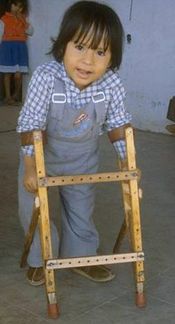Hesperian Health Guides
Helping the Child Develop
For the child to progress through the early stages of development, it is important that he can.
| SEE STRAIGHT AHEAD | SIT WITH HIS HANDS FREE | EXPLORE HIS SURROUNDINGS | STAND WITH HIS HANDS FREE | SIT, STAND, AND WALK |
| NO SPINA BIFIDA | ||||
 |
 |
 |
 |
 |
| SPINA BIFIDA | ||||
 |
 |
 |
 |
 hinges |
| If she cannot get herself into a position where she can see what is happening in front of her, lie her on a ‘wedge’ or fix a carton or box so she can sit leaning back in it. | You can make a seat from an old bucket or some other object, so that she can sit and play. | You can make a little cart that helps her to move. The cart can have a handle so that another person can push it. | Make a standing frame that holds her in a standing position. Holding up the weight of her body on her legs will strengthen her bones, so they will not break as easily. | She can use a brace that holds her up, so that she can walk with crutches. It helps if the brace has hip and knee hinges so that she can sit down (see "Standing and Walking Frame"). |
 |
When adapting aids for children with spina bifida, remember that each child is different. Some children manage to walk without braces, perhaps with the aid of parallel bars like these, and later crutches. Others will need above-knee or below-knee braces (see Chapter 58). Other children will need wheelchairs. |
 |
This child with spina bifida learned to walk using elbow crutches adapted to form a walker. As his balance and control improved, the supports on the crutches were gradually removed until he could walk with the crutches alone. |
Surgery and orthopedic corrections
To prevent or correct foot contractures in many children, it may be necessary to straighten the feet in the same way as for club feet. So that the contractures do not come back, the children will need to do exercises (see "Correcting Club Feet" and "Stretching Exercise to Help Your Child Put Her Foot Down Flat") and perhaps use simple plastic braces, at least at night.
For curving of the spine, if severe, some children need surgery or a body brace.
For children with spina bifida who have one hip dislocated, corrective surgery is sometimes helpful. But surgery generally is not recommended for those children with both hips dislocated. Usually they will walk just as well, and with fewer complications and less suffering, if the hips are left dislocated (see “Hip Problems”.)


